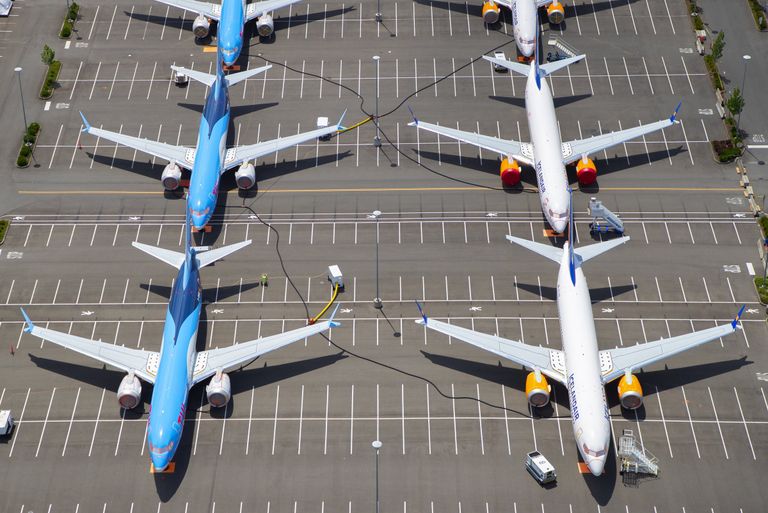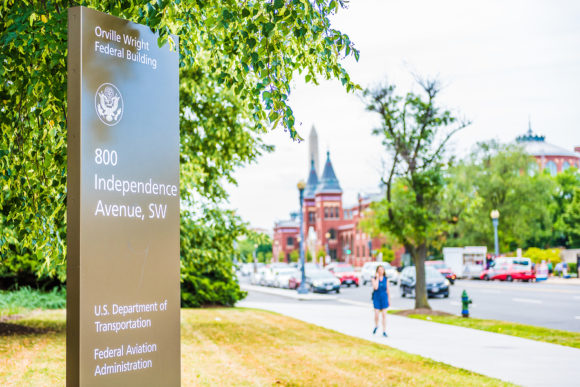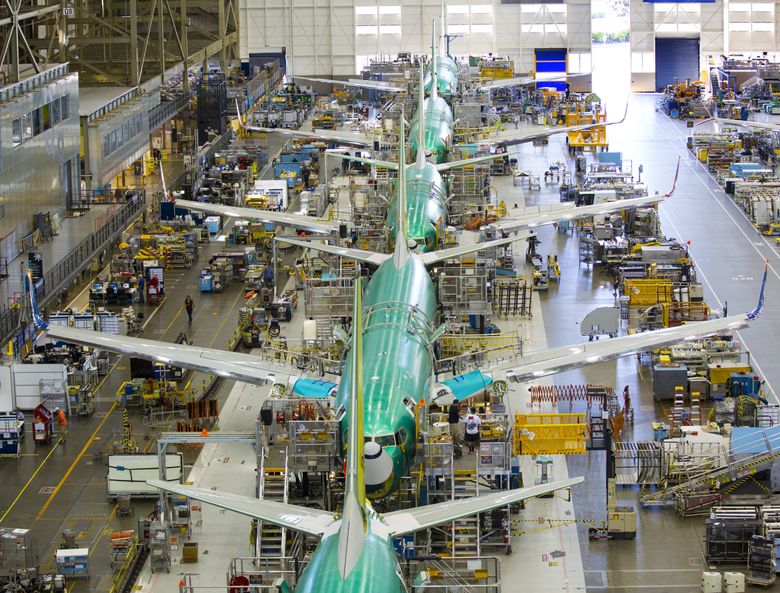Boeing and FAA give more signs of preparations for a 737 MAX
return to flight Thursday brought more strong hints that Boeing and the Federal Aviation Administration are moving steadily toward ungrounding the 737 MAX as soon as October. The FAA said Thursday it's inviting "a cross-section of line pilots from carriers that operate the aircraft around the world" to participate in simulator testing "as part of the overall testing and validating of new procedures on the Boeing 737 MAX." And according to two sources with knowledge of the matter, the FAA's Flight Standardization Board that determines U.S. pilot-training requirements aims to issue in early September new recommendations for exactly what MAX pilot training is needed before U.S. airlines can fly passengers on the airplane again. Meanwhile, Boeing gave suppliers a new 737 production schedule reflecting "timing assumptions for the 737 MAX return to service plan." The updated schedule is aggressive. Assuming FAA clearance in October, Boeing plans to begin the ramp-up immediately, moving from the current 42 planes per month to the pre-crash production level of 52 jets per month by February and reach a new high of 57 jets per month by next summer. The simulator sessions the FAA plans for line pilots will test new procedures related to Boeing's the updated Maneuvering Characteristics Augmentation System (MCAS) flight control software, the original version of which went haywire in the two fatal MAX crashes in Indonesia and Ethiopia and repeatedly pushed the nose of each jet down. Because of a potential new computer glitch discovered in June, pilots may also run through separate procedures handling uncommanded nose-down movements unrelated to MCAS. Boeing and FAA pilots have been testing the updated MCAS software for months. What's significant is that the FAA is now inviting regular 737 MAX line pilots to do the same. The assumed response time of pilots to an emergency, whether due to MCAS or not, has been under scrutiny since the crash of the Ethiopian Airlines MAX in March, when the pilots tried and failed to follow a standard recovery checklist. FAA guidelines say that if an emergency arises on a plane flying by autopilot, the assumption is that a pilot will begin to respond within three seconds. If the plane is being flown manually, the assumption is one second. When FAA test pilots deliberately delayed their responses in a simulation in June, one of the pilots crashed the plane. The safety agency said the line pilots now being invited to the new simulator tests will be pilots with "previous experience at the controls of the Boeing 737 MAX." "A firm schedule for these tests has not been set, although they must be completed before the aircraft is approved for return to service," the FAA said in a statement. Those simulator sessions are designed to validate the safety of the MAX with a regular pilot at the controls. Dennis Tajer, an American Airlines captain and spokesman for the Allied Pilots Association union, said that "anything that gets the average line pilot in to test that system - not the top test pilot at Boeing but an average 737 pilot - that's realistic analysis and we're encouraged to hear that." At the same time, the FAA's Flight Standardization Board (FSB) is preparing to issue new guidelines early next month for the training that all U.S. airline pilots must receive before flying the MAX again. In April, the board issued a draft report after reviewing the initial MCAS fix Boeing had designed, which it "found to be operationally suitable." That report said full-flight simulator training, which is time-consuming and expensive for the airlines, is unnecessary ahead of clearing the plane to fly again. Instead, the board recommended only a short computer-based course and classroom instruction about the new software update. That report was shelved as Boeing's software update kept getting pushed further out. If the new training outline coming in September sticks to the previous recommendation that simulator training is not needed, that will boost the MAX's return-to-service schedule, which is crucial to the airlines and to Boeing. The U.S. airline-pilot unions have said they could support such a recommendation provided that training specifically on how to handle uncommanded movement of the horizontal tail is included in the recurrent simulator training that every U.S. airline pilot must go through, typically every nine months or so. The report by FAA's Flight Standardization Board coming in September will have a comment period no longer than 30 days to gather input from the airlines and pilots before it's finalized and made mandatory. This timeline meshes with Boeing's publicly stated hope to get the MAX flying again commercially "in the early fourth quarter." Even if the FAA doesn't mandate simulator training before the MAX returns to flight, there's no guarantee for Boeing that some overseas regulators won't come up with different requirements. But most foreign safety agencies seem likely to follow the FAA's lead. Separately, Boeing said Thursday that, contingent upon FAA clearance, it has come up with a new 737 MAX production schedule that can meet the target set by Boeing Chief Executive Dennis Muilenburg in July: ramping up to a new production level before the end of 2020. Boeing said the production plan, which has been communicated to suppliers, "assumes a gradual increase in the 737 production rate from the current 42 per month to 57 per month in 2020." On Thursday, Reuters outlined the planned incremental steps, citing supplier sources. The Reuters report said Boeing's plan is to increase production from 42 to 47 aircraft per month in October, as soon as regulatory approval to fly is granted. It would then increase production to the pre-crash rate of 52 aircraft per month in February, and to 57 jets per month in June 2020. Still, all of this timing depends upon the regulators, here and overseas. Boeing cautioned in its statement that "while the assumption reflects Boeing's best estimate at this time, the actual timing of return to service will be determined by the FAA and other global aviation regulatory authorities." |
U.S. FAA says it will invite global Boeing 737 MAX pilots to
simulator tests

CHICAGO/WASHINGTON, Aug 22 (Reuters) - The
U.S. Federal Aviation Administration said on Thursday it would invite Boeing 737
MAX pilots from across the world to participate in simulator tests as part of
the process to recertify the aircraft for flight following two fatal
crashes.
Earlier, Reuters reported that the agency had asked the three U.S. airlines
that operate the MAX to provide the names of some pilots who had only flown the
737 for around a year, including at least one MAX flight.
In a statement, the FAA said it had not specified the number of required
hours of flight experience, but said the candidates would be a cross-section of
line pilots and must have experience at the controls of the MAX.
Boeing Co's latest 737 narrow-body model, the MAX, was grounded worldwide
in March after two crashes within five months in Indonesia and Ethiopia that
killed 346 people.
Boeing has been reprogramming software for a stall-prevention system at the
center of both crashes, which the FAA must approve before the plane flies again
commercially.
The FAA said it had not yet specified a firm schedule for the
tests.
Boeing has said it is working toward getting the 737 MAX flying again
commercially in the early fourth quarter. Reuters reported on Thursday that it
had told suppliers it planned to ramp 737 production back up in February,
sending its shares 4% higher.
The world's largest planemaker slowed its 737 production rate in April
because deliveries of the MAX, which makes up the bulk of its single-aisle
production, were frozen under the grounding, hitting its supply chain and
airline customers.
In the United States, MAX operators Southwest Airlines Co , American
Airlines and United Airlines have had to cancel hundreds of daily flights as
they wrestle with slimmer fleets at a time of strong domestic air travel
demand.
The MAX is Boeing's fastest-selling aircraft, with about 5,000 pending
orders.
As part of its own testing process, Boeing has invited senior airline
pilots to experiment with the software fix and use simulators to run scenarios
similar to the ones that led to the two crashes.
But sources told Reuters that the FAA also wanted to observe newer 737
pilots. One source said the simulator tests were supposed to be conducted during
the first week of September but had been pushed back to the middle of the
month.
The FAA, which is working alongside global regulators, has said repeatedly
it does not have a fixed time line to approve the grounded jets to fly
commercially again.
Trump Administration Appoints Aviation Safety Advisory Panel  U.S. Transportation Secretary Elaine Chao on Thursday named 22 people to a new panel that will advise the department on aviation safety oversight and certification programs as the Federal Aviation Administration continues to grapple with the fallout from two fatal Boeing 737 MAX crashes. The long-time practice of the FAA delegating certification tasks to aircraft manufacturers has come under criticism after the two 737 MAX crashes in five months. The panel, created last year by Congress, will offer input on "aircraft and flight standards certification processes, oversight of safety management systems, risk-based oversight efforts, and utilization of delegation and designation authorities," the department said. The panel will be chaired by former Alaska Airlines Chief Executive William Ayer. It includes officials from Delta Air Lines, GE Aviation, United Airlines, Bell Helicopter Textron, Garmin, Wing Aviation LLC, Pratt & Whitney - a unit of United Technologies Corp - and Gulfstream - a unit of General Dynamics Corp - as well as union, airport and trade association officials. Beth Pasztor, vice president for safety, security and compliance at Boeing Commercial Airplanes, is also on the panel. Federal prosecutors, the Department of Transportation's inspector general, Congress and several blue-ribbon panels are investigating how the FAA certifies new aircraft and the decision to certify the 737 MAX. Last month, U.S. National Transportation Safety Board Chairman Robert Sumwalt said his agency would outline recommendations on the FAA's aircraft certification procedures by late September. Awaiting 737 MAX approval, Boeing looks to boost aircraft production: sources  SEATTLE - Boeing Co has told suppliers it will resume production of its best-selling 737 jets at a rate of 52 aircraft per month in February 2020, then stepping up to a record 57 jets monthly in June, three people familiar with the matter told Reuters. Boeing told more than 100 suppliers during at least one Web meeting July 30 that the new schedule depended upon regulators approving the 737 MAX to fly again commercially in the fourth quarter, one of the people said. Shares of Boeing, the largest U.S. exporter with about 145,000 employees, were up 4.5 per cent at $355.18. Boeing mainly builds the latest version of its cash-cow single-aisle family at its Seattle-area factory, but also builds a small number of earlier or military variants of the 737. One of the people expressed skepticism over the timing given the intense scrutiny from regulators that grounded the 737 MAX after deadly crashes killed nearly 350 people in Ethiopia and Indonesia in the span of five months. There is no guarantee when regulators will clear the 737 MAX to fly again, and Boeing Chief Executive Dennis Muilenburg told analysts last month that Boeing would consider further 737 output cuts or potentially suspending production if the grounding dragged on. In April, Boeing cut the number of 737s it produces monthly to 42 from 52 after halting deliveries to airline customers, cutting off a key source of cash and hitting margins. Because the grounding happened when Boeing was going up towards record production levels, and each move of the sprawling supply chain has to be planned far in advance, Boeing and its suppliers are now caught between two conflicting pressures: preparing to get back on the upward path as soon as the plane is flying but also ratcheting downwards if regulators stall and the grounding continues for longer than expected. Boeing has been tight-lipped about its production plans. Muilenburg told analysts last month that Boeing expects to be able to maintain its current monthly production rate of 42 aircraft, "followed by incremental rate increases that would bring our production rate to 57 during 2020." Two persons familiar with Boeing's production plans, who spoke to Reuters on condition of anonymity, said Boeing told suppliers it will increase production from 42 to 47 single-aisle aircraft per month in October, jibing with its guidance to investors on when it expects to win regulatory approval. It would then increase from 47 aircraft to the pre-crash rate of 52 aircraft per month in February 2020, the people, and a third person familiar with the plans, said. Boeing then would hit a record stride of 57 single-aisle jets per month in June 2020, two of the people said. In response to questions from Reuters, Boeing spokesman Paul Bergman said Boeing updated the 737 master production schedule to reflect timing assumptions for the 737 MAX return to service plan. "While the assumption reflects Boeing's best estimate at this time, the actual timing of return to service will be determined by the FAA and other global aviation regulatory authorities and could differ from this assumption and estimate." The current production plan represents a new delay as Boeing wrestles with the logistics of aligning a sprawling global supply chain with its high-volume assembly line in Renton, Washington. Rate changes by major manufacturers are usually incremental and communicated months or even years in advance, but the unprecedented challenge to the 737 program has forced Boeing to scramble, one of the people said. Boeing is eager to increase production because the higher rate means it can deliver more planes and get more cash. A higher rate also means Boeing pays less for parts. Boeing organized at least one Web meeting on July 30 to inform suppliers that the original rate ramp plan - which Boeing decided in April would begin in August - was being delayed by three months, according to electronic materials described to Reuters by a person who attended. Different suppliers were shipping at different "rate profiles" and Boeing wanted to try to "harmonize the supply chain," the person added. |



Ingen kommentarer:
Legg inn en kommentar
Merk: Bare medlemmer av denne bloggen kan legge inn en kommentar.